
These fellows are not being serious about safety...
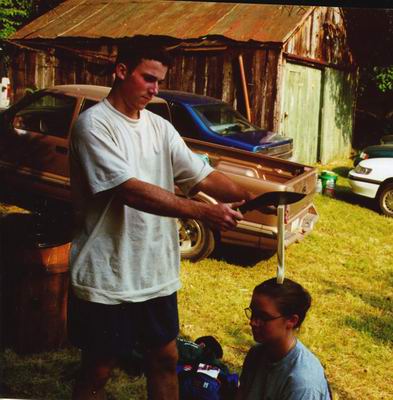
Neither is this fellow...Do NOT do this at home or anywhere else!!!

1. A khukuri is a tool which has a
sharp blade. It can and is used for many useful tasks. It is not a toy. Treat
it with the respect that it deserves.
2. Take the time to learn how to handle
a khukuri properly. You'll find that your use will be more efficient and
enjoyable.
3. Always handle and use your khukuri
with safety in mind. If you are not 100% dedicated to safety, you have
no business using a khukuri.
Below are some examples of things not to do and consequences:

These fellows are not being serious about safety...

Neither is this fellow...Do NOT do this at home or anywhere else!!!
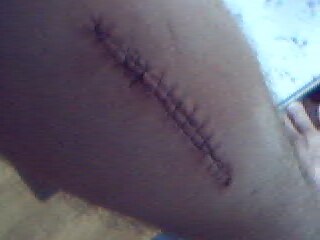
And this is an example of the damage a khukuri can cause.
4. Even when a khukuri is being sheathed
and unsheathed, safety should be kept in mind.
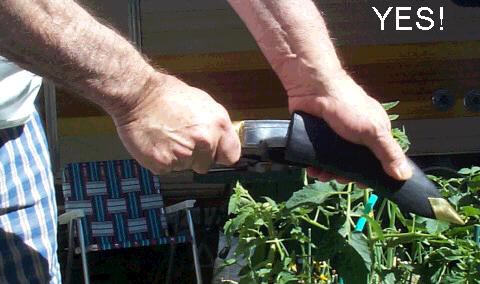
Notice how the user keeps his hand away from the edge area.
And the wrong way to unsheath/sheath a khukuri...:
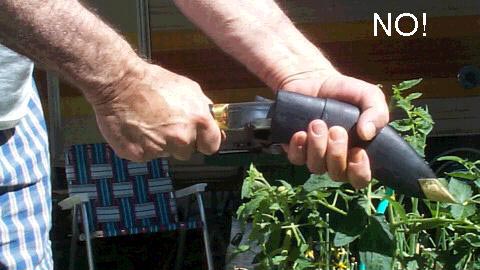
The fellow handling this khukuri was lucky to avoid serious injury to
his hand. He could have ended up like this:
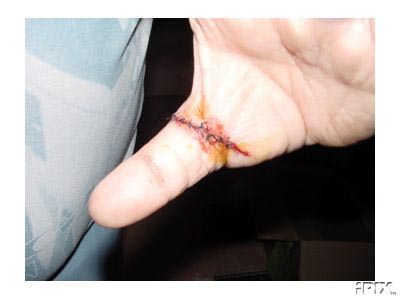
5. Watch out for the sharp chape!!
(this is the sharp brass thing covering the tip of the scabbard) Take a file
and round it off or remove it completely.
6. Maintain your khukuri. Keep it sharp and make sure that
it fits snugly in its scabbard.
If it needs repairs, consult Uncle Bill and the khukuri experts at the
Himalayan Imports Forum for advice.
7. If you are allowing others to handle your khukuris, make
sure that you instruct them on how you expect them to handle them.
This is for their safety and yours. If any doubt exists as to safety,
do not let them handle your khukuris.
After all, what responsible khukuri owner/user would give a sharp knife
to an idiot? Remember, you are responsible for your khukuri.
8. If you see another person using
a khukuri in an unsafe manner, stop and instruct them in safe khukuri use.
You, and they, will be glad you did.
9. Once more, a khukuri is NOT
A TOY!!! It is a sharp tool that can hurt you and others if not used
with safety in mind.
10. The pictures and information above
were provided by Uncle Bill Martino, Tom Marker, Russell Slate, MauiRob,
Howard Wallace's Khukuri FAQ, Terry Sisco and other responsible khukuri users.
11. The author of this safety thread is not responsible in
any way if you misuse a khukuri and hurt yourself in any way.
You, and you ALONE are responsible for your actions. No exceptions.
Controlled safe cutting principles... By Ferrous Wheel
As per a request, I'm adding this to the safety thread. Think of it as
prevention...
Consider these principles when or before attacking some unsuspecting lumber
with your khuk:
1 - Controlled Striking with the
primary cutting edge:
Before cutting hard targets, it is best to practice controlled striking
(with the hardened area--have to determine that as well) on softer targets,
like 2x4s and limbs. You can tell you're ready to move on to harder targets
once you can always hit with the hardened area of the khuk (you can tell
this by looking at marks on the blade made by cutting wood--they should mostly
be in the primary cutting area).
Conveniently, the Center of Percussion -- the 'sweet spot' -- of each
HI khuk is the zone that is hardest. It is no accident that this is the
primary cutting area of the khuk, and will deliver the most efficient cut.
2 - Controlling force and depth
of strike:
When you swing the khuk at the target, do not think of striking at the
surface of the target--but through it or many inches into it. Try cutting
plywood edge-on to master this technique. You can draw a line 3-4 inches
down on the side of the plywood, and aim for that depth of cut. This also
makes you conscious of blade control--by cutting TO the line, not through
it or above it, you learn to stop the khuks downward descent so that it does
not exit the target out of control and into one's leg or arm or rocky ground...you
also get a feel for the strikes that are too weak or not perpendicular to
the target. As you must initiate the swing, so must you terminate the swing
in a controlled fashion.
3 - Ignore the Point (or tip) of
the khuk:
When using the khuk for cutting, realize that the tip (meaning the part
of the blade that extends past the sweet spot) is really not the cutting
area--The point is the secondary cutting area of the khuk. Most folks when
swinging a sword or long blade for the first time want to strike with the
point. This is not the sweet spot, and delivers an ineffective cut with no
mass behind it (and using the softer tip, also a no-no).
Basically, the last few inches of the khuk are there to put mass further
out past the sweet spot, which is mass that converts to a more forceful blow.
The tip is there to roll the blade through the target without snagging.
When test cutting, ignore the tip of the khuk--act as if the khuk stops
right after the hardened area. You will be surprised how well the tip of
your khuk will hold up when it it not used as a primary chopping edge.
4 - Think in arcs:
Unlike a spear, arrow, or bullet, a khuk does not trave in a line. It
and other swung objects travel in an arc. When you swing your khuk, be aware
of the start and finnish (and everything in between) of the arc. Be aware
that anything that gets in this are is subject to being cut. Check the path
of the arc by envisioning the swing, and make sure there are no obstructions.
5 - Cut away from yourself:
This basic rule for all knife use is paramount in khuk use, as they have
two deadly ingredients --- mass and sharpness. When thinking in terms of
arcs, the khuk arc should always start closer to you than where it ends up.
If you are swinging an arc that goes away from you but comes back close to
you as well, you must rethink this arc or you risk injury. We all know that
a khuk goes slicing thru most target materials much faster than we think it
will, so do not assume that the target will miraculously stop the khuk dead.
*Test cutting and extreme cutting principles*
Edge profile:
HI khuks are maed with different edge geometry, which can mean there are
different khuks for different tasks. I would not use a thinly profile blade
to cut wood, but it'd do a job on reeds, brambles, grass, uncerbrush (i.e
Gelbu special). I would not use a thicker profiled blade to cut lighter targets,
bur it would be perfect for chopping lots of wood or harder test targets.
The more obtuse the blade geometry, the better the blade will hold up to
exreme cutting--conversely, it may not cut as deeply as a thinner model.
Confirm your target:
Know the composition of your target, and ensure that it is not harder
than your khuk.
When cutting certain high carbon or spring steels could really chew up
a khuk. You can test target hardness by runnng the hardened are of the khuk
along the target material, like peeling a carrot or shaving a sliver from
a stick. If the khuk cuts or bites into the material, then you pretty well
know how things are gonna go. If the surface is resistant to the khuk and
the khuk will not bite, then you'd be better off not striking the target.
Keep in mind that it is possible to successfully cut small amounts or thinn
pieces of material as hard as the khuk by exercising the principlles in 1-5.
Proper technique can make all the difference.
Conclusion:
If you practice for a while, master blade control and can use your wrist
in conjunction with the swing to 'snap' the blow into the target, You will
be ready for safe and effective cutting.
_ _ _
Chopping Felled Trees
Here's one for all the khukuri lumberjacks out there. Let's say you just
felled a nice tree with your chainsaw, and now it's time to draw the trusty
khuk and set about de-limbing and such. Be dadgummed careful of any small
saplings the tree might have fallen across. They'll be bent over storing
energy just like the pole in a good snare setup. A large khuk will lop through
a wrist thick sapling with one good lick, suddenly and violently releasing
the energy stored in that bent sapling. A sapling of that diameter will recoil
with enough force to put out an eye, crush a windpipe, et cetera. So what
do you do? Don't cut either end, cut in the middle of the arc of the bent
piece of wood, and only enough until the wood cracks, releasing most of it's
energy. Same deal for limbs that are supporting the weight of the fallen
tree, they're storing energy too.
Before you ask, no, it's never happened to me, and I'm sure plenty of you
out there already knew about it, so I thank you for your patient indulgence.
It just occurred to me that there's a lot of brand new khuk users popping
up on the forum, and some of them may be new to chopping trees down/up. I've
been through several hurricanes and seen a lot of folks hurt trying to deal
with fallen trees. They can be very dangerous and entirely unforgiving.
----
AND PLEASE.....!!! From Kismet
1. Contain your initial enthusiasm.
2. Go slower when you are tired, and
be more deliberate in your actions.
3. Stop before the accident. The job will stay there until
you are rested.
Kis
Here's another safety article worth reading (Thanks to lcs37 for posting it):
Blade Safety (by Singularity)
Power Grinder
I cannot stress strongly enough the importance of watching what you are doing if you try polishing a blade like this on a power grinder!
I used to do a lot of buffing when I first started in the machine shop. This was done on a huge grinder and I have lost the small aluminum parts and almost lost my Cajones from getting Zapped with them! I have literally layed on a dirty grinding room floor gasping for breath when I got nailed by one of these small aluminum 'toe stops' for roller skates.
Guys if a Khukuri got loose from you on a grinder it would be much, much more serious than when the Kami hit that Khukuri wrong a while back and it went flying. You are going to be standing way to close You may lose more than your Cajones.
Yvsa
Safety at Plant 2
Just called Nepal this morning and got this report. Here's what happened. Two kamis are pounding in tandem on a 20 inch Sirupati held on the anvil by a third kami. One of the pounders missed his mark and hit the blade off the anvil. Of course, the blade flipped out of the tongs and went flying through the shop, narrowly missing a couple of the other kamis.
The kamis immediately held a conference and blamed the accident on the "improper blessing" done by the boss on the first shipment. They said this is also the reason the shipment was lost -- not properly blessed so Kali took it into her own hands to see that the khukuris did not reach the intended users without the proper blessing. Breaking an egg doesn't get it with the kamis and they insisted on a "proper" blessing. This involves a Kali puja so sister-in-law, Sanu, went out and bought the biggest, fattest hen she could find and took it back to the shop. Next shipment this hen was killed as Kali puja and the khukuris were properly blessed. Of course, the kamis happily cooked and ate the hen after the puja was complete.
Shop 1 also does Kali puja. It is part of the kami religion and culture. It may or may not be part of the khukuri blessing. This is up the the kamis...unless the boss happens to be Buddhist. From now on they will have their ceremony and the boss will have his. Equal opportunity!
Having the conference, acknowledging the accident, doing the Kali puja keeps what happened in the front of the thinking while manufacturing is going on. This is most important -- stay focused! The reason the guy missed is he lost his focus. He has the skill to never miss. He was thinking about something else, got distracted, needed to scratch his nose, whatever, but he should not have taken that swing. I will bet a dollar to a donut that he will not make this same mistake for a long time.
Bill Martino
Copyright (c) 1999-2001 by Howard Wallace, all rights
reserved.; 2002-3 Himalayan Imports.
This FAQ may not be included in commercial collections
or compilations, or distributed for financial gain, without express written
permission from the author. This FAQ may be printed and distributed
for personal non-commercial, non-profit usage, or as class material, as
long as there is no charge, except to cover materials, and as long as this
copyright notice is included.